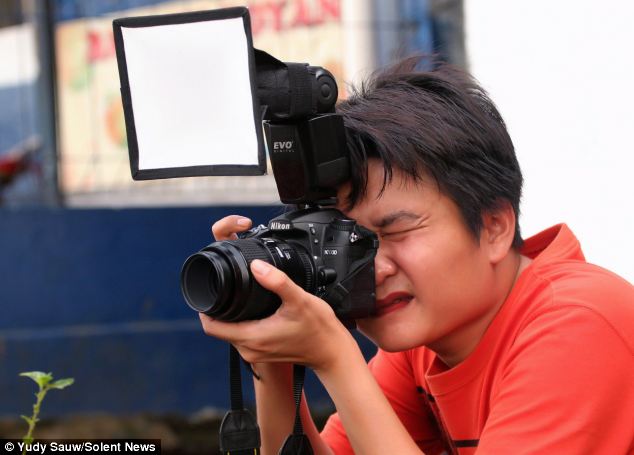Out of this world: Incredible close-up photos of insects that look like they could be aliens
- Images of Indonesian dragonfly, jewel frog beetle, bee, mantis and red ant reveal the intricate patterns and neon colours of their shells
- Photographer Yudy Sauw, from Tangerang, spent 10 minutes on each shot
They look like they've dropped down from another galaxy.
But these mesmerising figures are in fact a bunch of bees, beetles and ants.
In a collection of extraordinary close-ups, the insects' microscopic neon patterns that go unnoticed by humans are revealed.

Other-worldly: This is a tiger beetle - a species normally known for its fast pace and venemous attack

Different take: Photographer Yudy Sauw, of Tangerang in Indonesia, captured shots of numerous bugs including a jewel frog beetle, an ant, a bee and a mantis
And they aren't shy, obediently holding their glare for ten minutes at a time for the camera.
Among the assortment of everyday bugs in Indonesia, a jewel frog beetle, dragonfly, bee and red ant were all photographed to show off their intricate patterns.
Their miniscule hairs can be seen in great detail - which normally would be missed as they fly past.
Jewel Beetles, also know as Sagra buqueti in South East Asia, are commonly known as Frog Beetles due to the large back legs.

Toy-like: The mantis is a regal figure in the insect world - but this unusual image makes the willowy bug looks translucent, as if it is a toy made out of rubber

Character: This red ant looks like a character from a sci-fi film and the glaring sun highlights its features

While bees normally zoom past, Mr Sauw was able to capture one looking still and plump, almost like a manatee

Mesmerising: But close-up the bee looks just as alien-like as the others - with leopard spots on its eyes
Its outer shell is metallic green with a gold line running down its back.
Photographer Yudy Sauw from Tangerang, Indonesia, spent ten minutes on each picture of the tiny insects.
The flying bee was around 50cm away from Mr Sauw, while the extreme close-ups were taken from just 10cm away.

Neon: The obedient insects, which stayed still for ten minutes at a time, are covered in neon patterns that are too small and nuanced for the human eye to detect

Faces: In this bizarre image of a bug eating another, their eyes and stances seem to betray emotion
Mr Sauw had to be calm and patient when taking the photos, to prevent the tiny insects from flying away.
He said: 'All of the photographs were taken in my studio in Indonesia.
'You can see a jewel frog beetle, dragonfly, red ant and flying bee.

Mr Sauw spent weeks monitoring the insects and positioning himself to capture their glowing detail

Delicate: He had to get as near as 10cm away from his objects for ten minutes without scaring them away
'The flying bee was the only one moving, and luckily, the other insects managed to stay incredibly still.
'The extreme close-ups were only 10 centimetres away, which allowed me to capture clear macro photographs.
'All of the insects had to be incredibly still for the process to work.'
Most watched News videos
- Scottish woman has temper tantrum at Nashville airport
- Tesla Cybertruck explodes in front of Trump hotel in Las Vegas
- Mass panic as New Orleans attacker flies down Bourbon street
- Shocking moment zookeeper is fatally mauled by lions in private zoo
- Horrific video shows aftermath of New Orleans truck 'attack'
- Meghan Markle celebrates new year in first Instagram video
- See how truck that drove into crowd made it through police barrier
- Tesla Cybertruck burns outside Trump hotel in Las Vegas
- Cheerful Melania Trump bops to YMCA at Mar-a-Lago NYE bash
- New Orleans terror attack suspect reveals background in video
- Plane passenger throws drink at flight attendant in boozy fight
- Horrifying moment yacht crashes into rocks and sinks off Mexico coast





















































































